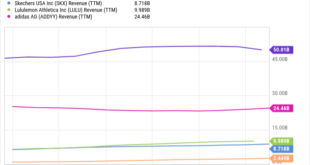Investors would probably love to hear a more decisive view. But , and these kinds of imprecise assessments are the best we can do as we manage our expectations.
That said, last week came with a lot of Wall Streeters pushing back on Goldman’s forecast.
JPMorgan Asset Management (JPMAM) expects large-cap U.S. stocks to “return an annualized 6.7% over the next 10-15 years,” .
“I feel more confident in our numbers than theirs over the next decade,” JPMAM’s David Kelly . “But overall, we think that American corporations are extreme — they’ve got sharp elbows and they are very good at growing margins.“
“In our view, a looming lost decade for U.S. stocks is unlikely if earnings and dividends continue to grow at solid paces boosted by higher profit margins thanks to better technology-led productivity growth,” Yardeni said.
Datatrek Research co-founder Nicholas Colas is encouraged by where the stock market stands today and where it could be headed.
“The S&P 500 starts its next decade stacked with world class, profitable companies and there are more in the pipeline,” Colas wrote on Monday. “Valuations reflect that, but they cannot know what the future will bring.“
He believes “the next decade will see S&P returns at least as strong as the long run average of 10.6%, and possibly better.“
Colas noted that historical cases of <3% returns “always have very specific catalysts which explain those subpar returns.“ The Great Depression, the oil shock of the 1970s and its after effects, and the Global Financial Crisis were all associated with these low 10-year returns.
“History shows that 3% returns or worse only come when something very, very bad has occurred,” Colas said. “While we are relying on press accounts of Goldman’s research, we have read nothing that outlines what crisis their researchers are envisioning. Without one, it is very difficult to square their conclusion with almost a century of historical data.“
Because of the way Wall Street research is distributed and controlled, not everyone is able to access every report, including experts who may be asked to respond to them.
Goldman shared the report with TKer. Regarding the issue Colas flagged, Goldman does discuss those catalysts but actually highlights them as .
That said, very bad things have happened in the past, and they could happen again in the future. And those events could cause stock market returns to be poor.
“Forecasting one form of economic disaster or another over the next 10 years is not much of a reach; you will be hard-pressed to think of any decade where some economic calamity or another didn’t befall the global economy,” Barry Ritholtz of Ritholtz Wealth Management . “But that’s a very different discussion than 3% annually for 10 years.”
This leads me to my conclusion: It is very difficult to predict with any accuracy what will happen in the next 10 years. in their report. There are good cases to be made for weak returns as well as strong returns as argued by Yardeni and Colas.
Who will be right? We’ll only know in hindsight.
Generally speaking, I’m of the mind that the because we have a , and earnings are the . And there’s never been a challenge the economy and stock market couldn’t overcome. After all, .
“I have no idea what the next decade will bring in terms of S&P 500 returns, but neither does anyone else,” Ritholtz . “I do believe that the economic gains we are going to see in technology justify higher market prices. I just don’t know how much higher; my sneaking suspicion is one percent real returns over the next 10 years is way too conservative.”
There were a few notable data points and macroeconomic developments from last week to consider:
Card spending data is holding up. From JPMorgan: “As of 15 Oct 2024, our Chase Consumer Card spending data (unadjusted) was 1.5% above the same day last year. Based on the Chase Consumer Card data through 15 Oct 2024, our estimate of the U.S. Census October control measure of retail sales m/m is 0.69%.“
From BofA: “Total card spending per HH was up 1.9% y/y in the week ending Oct 19, according to BAC aggregated credit & debit card data. Spending growth has recovered in the sectors that were most impacted by Hurricane Milton, e.g. clothing, furniture & transit. Even beyond these sectors, we saw broad-based increases in spending growth in the week ending Oct 19.“
Unemployment claims tick lower. declined to 227,000 during the week ending October 19, down from 242,000 the week prior. This metric continues to be at levels historically associated with economic growth.
Consumer vibes improve. From the University of Michigan’s : “Consumer sentiment lifted for the third consecutive month, inching up to its highest reading since April 2024. Sentiment is now more than 40% above the June 2022 trough. This month’s increase was primarily due to modest improvements in buying conditions for durables, in part due to easing interest rates.”
Home sales fall. decreased by 1% in September to an annualized rate of 3.84 million units. From NAR chief economist Lawrence Yun: “There are more inventory choices for consumers, lower mortgage rates than a year ago and continued job additions to the economy. Perhaps, some consumers are hesitating about moving forward with a major expenditure like purchasing a home before the upcoming election.”
Home prices cooled. Prices for previously owned homes declined from last month’s levels, but they remain elevated. From the : “The median existing-home price for all housing types in September was $404,500, up 3.0% from one year ago ($392,700). All four U.S. regions registered price increases.”
New home sales rise. jumped 4.1% in September to an annualized rate of 738,000 units.
Mortgage rates tick higher. According to , the average 30-year fixed-rate mortgage rose to 6.54%, up from 6.44% last week. From Freddie Mac: “The continued strength in the economy drove mortgage rates higher once again this week. Over the last few years, there has been a tension between downbeat economic narrative and incoming economic data stronger than that narrative. This has led to higher-than-normal volatility in mortgage rates, despite a strengthening economy.”
There are in the U.S., of which 86 million are and of which are . Of those carrying mortgage debt, almost all have , and most of those mortgages before rates surged from 2021 lows. All of this is to say: Most homeowners are not particularly sensitive to movements in home prices or mortgage rates.
Offices remain relatively empty. From : “Peak day office occupancy on Tuesday fell seven tenths of a point last week to 60.7%. Most of the 10 tracked cities experienced lower peak day occupancy than the previous week, likely due to the federal holiday on Monday. Los Angeles had its highest single day of occupancy since the pandemic, up 1.9 points from the previous Tuesday to 56.3%. The average low across all 10 cities was on Friday at 31.9%, down eight tenths of a point from the previous week.“
CEOs are less optimistic. The Conference Board’s in Q4 2024 signaled cooling optimism. From The Conference Board’s Dana Peterson: “CEO optimism continued to fade in Q4, as leaders of large firms expressed lower confidence in the outlook for their own industries. Views about the economy overall—both now and six months hence — were little changed from Q3. However, CEOs’ assessments of current conditions in their own industries declined.
Moreover, the balance of expectations regarding conditions in their own industries six months from now deteriorated substantially in Q4 compared to last quarter. Most CEOs indicated no revisions to their capital spending plans over the next 12 months, but there was a notable increase in the share of those expecting to roll back investment plans by more than 10%.“
Survey signals growth. From S&P Global’s : “October saw business activity continue to grow at an encouragingly solid pace, sustaining the economic upturn that has been recorded in the year to date into the fourth quarter.
The October flash PMI is consistent with GDP growing at an annualized rate of around 2.5%. Demand has also strengthened, as signalled by new order inflows hitting the highest for nearly one-and-a-half years, albeit with both output and sales growth limited to the services economy.”
Keep in mind that during times of perceived stress, soft data tends to be more exaggerated than actual hard data.
Business investment activity ticks higher. for nondefense capital goods excluding aircraft — a.k.a. — increased 0.5% to a record $74.05 billion in September.
Core capex orders are a , meaning they foretell economic activity down the road. While the growth rate has , they continue to signal economic strength in the months to come.
Most U.S. states are still growing. From the Philly Fed’s September report: “Over the past three months, the indexes increased in 34 states, decreased in 10 states, and remained stable in six, for a three-month diffusion index of 48. Additionally, in the past month, the indexes increased in 36 states, decreased in seven states, and remained stable in seven, for a one-month diffusion index of 58.”
Near-term GDP growth estimates remain positive. The sees real GDP growth climbing at a 3.3% rate in Q3.
The outlook for the stock market remains favorable, bolstered by . And earnings are the .
Demand for goods and services as the economy continues to grow. At the same time, economic growth has from much hotter levels earlier in the cycle. The economy is these days as .
To be clear: The economy remains very healthy, supported by very . Job creation . And the Federal Reserve – having – has .
Though we’re in an odd period in that the hard economic data has . Consumer and business sentiment has been relatively poor, even as tangible consumer and business activity continue to grow and trend at record levels. From an investor’s perspective, is that the hard economic data continues to hold up.
That said, analysts expect the U.S. stock market could , thanks largely due to . Since the pandemic, companies have adjusted their cost structures aggressively. This has come with and , including hardware powered by AI. These moves are resulting in positive operating leverage, which means a modest amount of sales growth — in the cooling economy — is .
Of course, this does not mean we should get complacent. There will — such as , , , , etc. There are also the dreaded . Any of these risks can flare up and spark short-term volatility in the markets.
There’s also the harsh reality that and are developments that all long-term investors to experience as they build wealth in the markets. .
For now, there’s no reason to believe there’ll be a challenge that the economy and the markets won’t be able to overcome over time. , and it’s a streak long-term investors can expect to continue.
A version of this post first appeared on TKer.co
 meganwoolsey Home
meganwoolsey Home

